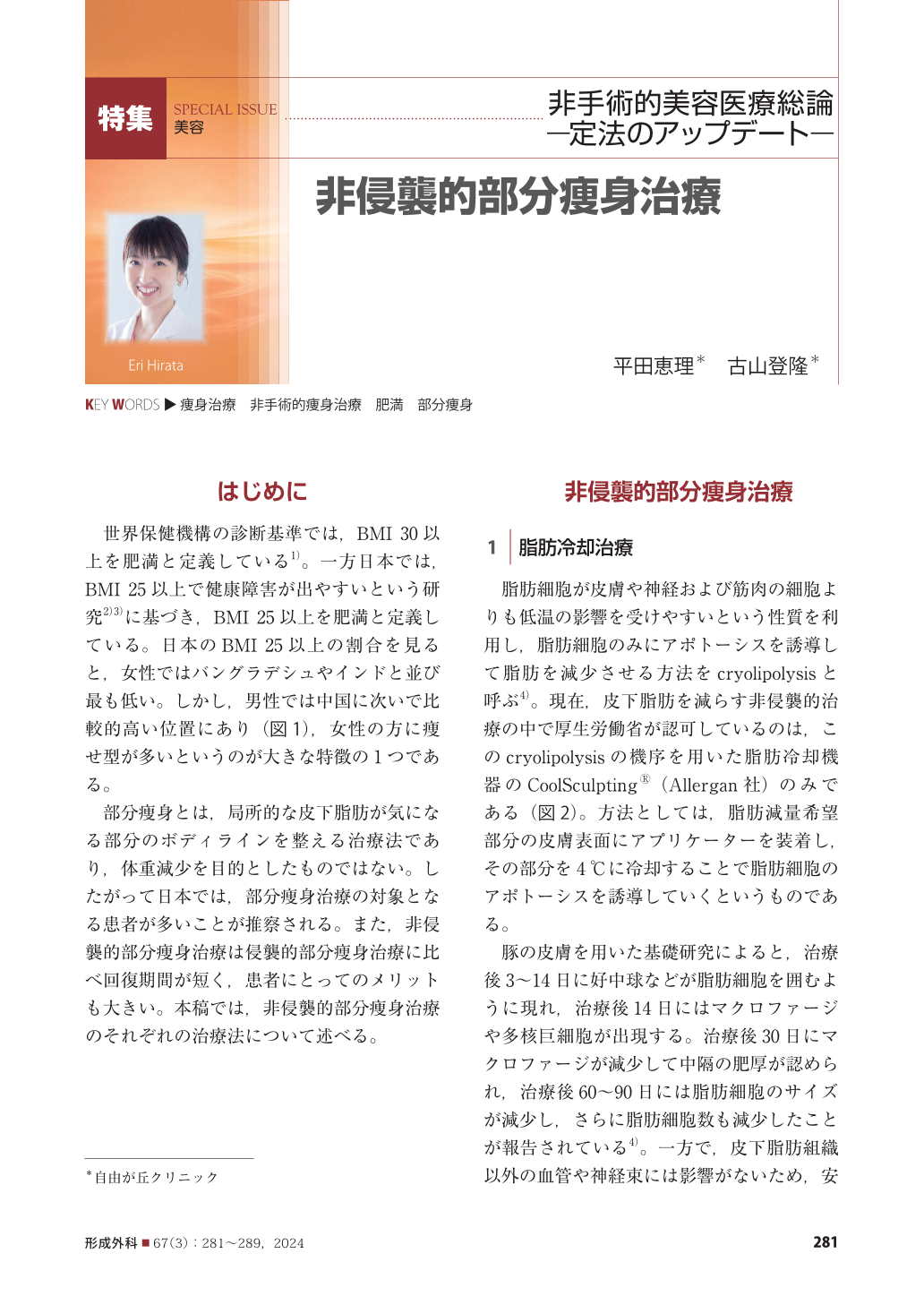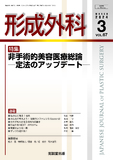Japanese
English
- 有料閲覧
- Abstract 文献概要
- 1ページ目 Look Inside
- 参考文献 Reference
はじめに
世界保健機構の診断基準では,BMI 30以上を肥満と定義している 1)。一方日本では,BMI 25以上で健康障害が出やすいという研究 2)3)に基づき,BMI 25以上を肥満と定義している。日本のBMI 25以上の割合を見ると,女性ではバングラデシュやインドと並び最も低い。しかし,男性では中国に次いで比較的高い位置にあり(図1),女性の方に痩せ型が多いというのが大きな特徴の1つである。
部分痩身とは,局所的な皮下脂肪が気になる部分のボディラインを整える治療法であり,体重減少を目的としたものではない。したがって日本では,部分痩身治療の対象となる患者が多いことが推察される。また,非侵襲的部分痩身治療は侵襲的部分痩身治療に比べ回復期間が短く,患者にとってのメリットも大きい。本稿では,非侵襲的部分痩身治療のそれぞれの治療法について述べる。
In recent years, non-invasive body-shaping treatments have been in high demand. This is because, in most cases, they do not involve a recovery period that interferes with daily life. Currently, the only non-invasive body-shaping treatment that has been approved by the Ministry of Health, Labor and Welfare is CoolSculpting Ⓡ, which uses a fat-cooling device. It can be performed relatively safely in areas where the applicator can be securely attached; however, while incidence is low, the side effect of paradoxical hyperplasia has been reported. Laser treatment is another method that may be effective for patients with sagging skin who wish to perform skin tightening. However, it requires a certain amount of subcutaneous fat, since the laser penetration depth is approximately 2.5–3.0 cm, similar to fat-cooling devices. High-intensity focused ultrasound (HIFU) also requires that the irradiation depth be precisely within the fat layer, and problems arise if the irradiation is too shallow or too deep. It is considered easy to perform, and is sometimes done at beauty spas, but complications such as burns caused by poor contact with the probe often occur. Unlike these treatments, the Mesotherapy treatment method does not depend on the thickness of subcutaneous fat. As it is only necessary to pinch the skin and inject medicines into the subcutaneous fat layer, it is often performed in small areas, such as under the chin. There are many types of Mesotherapy agents, with varied timing in terms of when patients begin to feel the effects, and the number of and intervals between applications of the agent. It is important to know the differences that arise from each ingredient.In conclusion, it is essential to understand the differences, pros and cons of these non-invasive body-shaping treatments.
According to the World Health Organization (WHO), obesity is defined as BMI of ≥30. However, in Japan, the definition of obesity is BMI ≥25, based on research indicating increased health risks. When looking at the prevalence of BMI ≥25 in Japan, females have the lowest rates, similar to countries like Bangladesh and India, while males have relatively higher rates, following China. This indicates a notable prevalence of lean body types among females.Partial body contouring treatments are used to address specific areas of localized fat in non-obese patients, with the goal of improving the appearance of those areas. It is important to note that these treatments are not intended for weight loss purposes. For patients who desire weight loss, it is necessary to emphasize the importance of incorporating exercise therapy and dietary changes. Non-invasive partial body contouring treatments offer benefits such as shorter recovery periods compared to invasive procedures. However, it is crucial to discuss and select the appropriate treatment option based on individual needs, and to provide information about the likely effectiveness and potential side effects associated with each method.

Copyright© 2024 KOKUSEIDO CO., LTD. All Rights Reserved.


